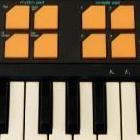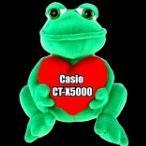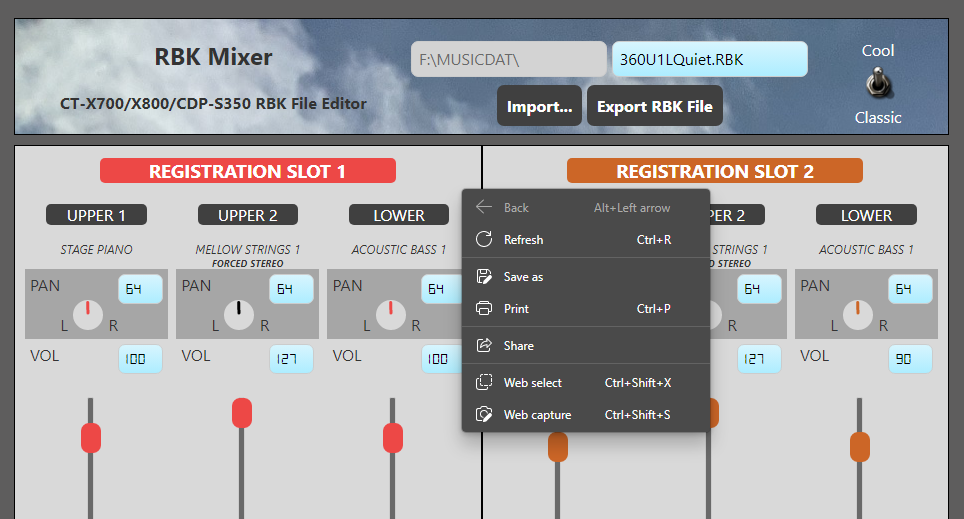-
Posts
551 -
Joined
-
Last visited
Recent Profile Visitors
The recent visitors block is disabled and is not being shown to other users.
Chandler Holloway's Achievements
-
Börje Westerlund started following Chandler Holloway
-
Toneymaru started following Chandler Holloway
-
Patri.Mendez. started following Chandler Holloway
-
It's been brought to my attention that the IDES 4.0 software download page has gone offline. Makes some sense -- that webpage was nearly 20 years old and all of the keyboards to which it directly pertained have been off the market for quite some time. It had a good run. However, the Rhythm Converter from the IDES 4.0 bundle still remains the only official Casio software for creating rhythms from MIDI files, so this presents a problem for modern day rhythm composers who don't want to pursue a third party software solution and would rather follow along with my guide. Fortunately, I kept a back-up of the original IDES 4.0 installer program on my hard drive, and I have re-hosted it here as an attachment to this post. The download link from my original post will redirect to a google drive back-up as well, so this should (hopefully) be a more future proof method of archiving the software. ides40.exe
-
Hi Warren, sorry for the delayed response. Might make more sense to move further troubleshooting to the github page if you keep having problems, the dev team is monitoring that more closely than this forum topic but we'll cross that bridge when we come to it. The sign that files have been properly imported is that the instrument names will update to show the tones you chose for your registrations. If your files include previous volume level adjustments (like my template files do), then the sliders and values will update along with the tone names. If you scroll down to the bottom of the RBK Mixer page and it still says "Importing..." in a gray text box after a long wait then something has gone wrong that is delaying the importing. These RBK files are just a bunch of numeric values that tell the keyboard which settings to adjust, so they're extremely small in terms of file size. They shouldn't be taking a long time to finish importing, often less than a second or two on my machine. Have you been able to get the template files I provided to load into your CDP-S360, un-edited? As in, bypassing RBK Mixer completely and just dropping the template files on to the flash drive and importing them via the Media menu on the S360. They should be able to provide the volume level tweaks you need in the meantime while we're troubleshooting RBK Mixer. Those template files were created using v.0.3.1 on my Windows machine, so if those loaded into your CDP-S360 without error (and recalling the Registration slots applies the volume level changes as expected), then we know the problem has to be with your installation or your computer. On the subject of your computer, first I'd like to get a System Information file from your primary Windows 11 machine. This file will tell me all the hardware and operating system specs of your machine (no private information, just the specs) just so I can verify that this isn't a bigger compatibility issue I've overlooked. I'm doubtful that it's a hardware or OS incompatibility but it doesn't hurt to check. If you're unsure of how to create a system information file, this guide should help. You can attach the .NFO file here in your response.
-
They were made on an S360, and you shouldn't need to edit the templates with RBK Mixer at all. The templates are pre-edited to make specific parts quieter. I figured there are enough combinations of volume levels that the banks will suit your needs, as-is, until you can figure out what's gone wrong with your computer. You can load them on to your S360 without any editing, then change the assigned tones, effects, rhythms, tempo etc and re-save a new registration in a different bank/slot. The screenshots included in the template files show the values for each slot in each file for reference. The only way I've been able to get the window to display no instrument names and go unresponsive to all input (as you seem to be describing) is if my last known import location was a flash drive that his since been removed from the computer. Like, if in my last session involved editing files on a flash drive, but I have removed that flash drive in the interim, the next time running RBK Mixer I get the mixer screen with no instrument names and a grey rectangle showing "loading" at the bottom of the window. But I've always been able to fix that by simply importing a new file that's not on a flash drive, like my documents folder. But you say you've been importing from and exporting to your documents folder already, so you shouldn't be having this issue at all. By "doesn't change anything", you mean you don't even see the option to refresh the screen? Like in this screenshot below?
-
The old version of RBK Mixer will not be able to export any S360 files due to the mismatch in the header data of the file. You will only ever get this to work on the new version, v0.3.1 On the new version, on either the Windows 11 or Windows 8 PC, has right clicking inside the window and selecting refresh ever made things start working? As in, added the instrument names and allowed the export button to work properly?
-
We had a Windows 11 tester during beta testing and he never had any problems, so I wouldn't think it's necessarily that. I'm not sure why your export button isn't working, but in the meantime, here's a .ZIP file containing a bunch of S360 templates. I apologize for the panning issues with the initial files, they should be fixed now. There's a separate folder in here called "Template Settings", containing screenshots of the settings for each slot in the RBK files. Again, you should be able to import the bank, switch up your tone selection, effects, tempo, rhtyhm etc and then re-save them in new registration slots. I would recommend reserving Bank 8 as a junk bank for loading in these temporary templates, then organize your actual registrations in banks 1-7 until you run out of space. If there's anything more specific you need, I can try to make you more custom banks, but obviously giving you the means to make them on your own is preferable. I'm unsure of what's causing your problems, but if you get it to work trying another Windows machine, let me know. In the meantime, hopefully these templates are enough to get the job done as a stopgap measure in the interim. I've let my dev partner know about your issues and we're not sure how to diagnose the problem given that it has worked properly on our computers. If I have any updates, I'll keep you posted. S360 Templates.zip
-
Hi Warren, Try this file (attached to this post), I made it for you using the same v.0.3.1 copy of RBK Mixer you tried to install. Registration Slot 1 has Piano at volume 100 out of 127, slot 2 has piano at 90 out of 127, slot 3 has piano at 80, slot 4 at 70. Hopefully one of them keeps the piano quiet enough for you. You asked for half volume on piano but in my experience, anything below 70ish is really dang quiet. It may load in with Upper 2 (strings) enabled, just turn that off and re-save it to the same slot if need be. The only S360 files I have on hand were from preliminary compatibility testing a long time ago so I don't really remember how I set them up. If you need to change the upper or lower tones around after loading them in, this won't undo the volume changes applied by RBK Mixer, so you can use these files as a template and just re-configure the tones on Upper1, Upper2 and Lower as needed. If this file loads in and you hear the volume changes properly, then the problem has to be with your computer or the installation somewhere along the line since I successfully used the exact same version of the software on my Windows 10 rig. Sometimes on the first run of the program, it may come up with a gray screen. Right clicking inside the gray window and clicking refresh should solve this problem, and fixes the issue of the instrument names not updating from time to time. When you go to load in your RBK files and it seems like the instrument names don't update, try right click -> refresh and see if that fixes it. Clicking the export button should give you an error message or a success message. If nothing happens when you click it, then something's definitely off. One thing that helped a past user with firewall/antivirus issues was uninstalling, re-running the .MSI installer and then selecting a location other than Program Files (the default installation location), like your Documents folder. You might have better luck this way, but I don't really know how your antivirus and firewall set-up interacts with the program so I don't know if I can recommend much else from here. I'll ask my dev buddy if there's another way we can diagnose your problem if you still can't get it working. WarrenS360Bank.RBK
-
Advanced tone editing is possible via the Tone Tyrant software, released by mrmr9494 here on the forums. The AiX sound engine has a complex envelope with multiple Attack and Release parameters that can approximate the decay and sustain functions on a synth with a normal four stage envelope. Casio built all this functionality into the .TON files themselves, but did not make the full set of parameters available via incoming MIDI CC or the built-in tone editor menu. I believe Tone Tyrant can also help with DSP block editing, but I haven't looked into that too deeply. Basically, you would do the preliminary tone edits through the built-in tone editor, and then when you reach the part of the sound design process where you need to tweak the hidden parameters, export the "rough draft" .TON to your computer for fine detailing via Tone Tyrant. Then you save the modified .TON and send it back to the CT-X for testing. Fortunately you can import and export files directly to the keyboard from within the program so there's not too much waiting to see the effect of your edits -- "realtime" software editing with instant updates has yet to be figured out. You can find the topic for Tone Tyrant here. Not too sure on the specifics of the 4 band EQ. You might try emailing Casio support to see if they can clarify, the information is not published anywhere as far as I'm aware.
-
Hi Warren, Thanks for pointing out the version number. Our releases page hadn't been updated to show the most recent version, which is my mistake for not reminding my dev partner to update it. We have a new version from July of 2022 that I personally tested with the CDP-S360 (version 0.3.1) I have attached the .MSI installer file to this post. Please uninstall the previous version of RBK Mixer and try this one (both direct from the MUSICDAT folder on your flash drive, and with it copied to your computer's storage). RBK Mixer_0.3.1_x64_en-US-1.msi
-
@WarrenF Hmmm, that’s odd. I’m guessing the problem might be caused by exporting the file directly back to the MUSICDAT folder on your flash drive, although that should still work (assuming the flash drive remains connected to your computer during this whole process). I’ll try a test on my Windows machine later but I don’t remember this being an issue during testing. Try this in the meantime: copy the unmodified RBK file to another folder on your computer (I.e. not inside MUSICDAT folder, and not on the flash drive at all). Then, when you open RBK Mixer and click import, select the file in its new location (on your computer’s local storage, not the flash drive) and import it. Make your changes to the volume levels and the name, and export the file to see if it gives you the error message. If it doesn’t give you the error, you should find the modified RBK file in the same folder as the original one (but again, it will be in your computer’s storage, not the flash drive). Copy this file back on to the MUSICDAT folder of your flash drive and then import it to your CDP-S360 to see if the volume changes work. This is mostly just to see if the flash drive is the issue. Importing and exporting directly from the flash drive shouldn’t be an issue, but if this workaround gets you up and running in the meantime, I can look into what might be causing the flash drive to give you an error. Another question: when you export with the same name from RBK mixer and it shows “success” does the “Last Modified” time stamp update as well (you can see this when you view the file in Windows file explorer) Even if the file name stays the same, RBK Mixer’s volume changes still constitute a modification to the file, so the time stamp should update to reflect the time that you clicked “Export”.
-
Hi Warren, Did you make sure to export the file from the software, give it a distinct name, and double check that you're loading the newly exported file into the S360? Exporting is shown briefly in the start-up guide video at 6:07 if that helps. If the values are all showing back at their default level of 127 when you bring them back into the software, it probably means you're looking at the original RBK, which would indicate you didn't export the edited one with your custom volume balance. As a side note, I would change the early part of the name of the .RBK file when exporting, the CDP-S360 display can only show eight characters of text at a time, so it can be easy to mix up RBK files during import if the only difference in the name is at the end of the file (e.g. "RegBankA" and "RegBankA v2" would look identical on the keyboard because only the first eight characters are actually shown in the CDP's media menu). If you double check the export and the updated name and it still doesn't work, attach your RBK file in a response in this thread and I'll take a look. Might be able to see what's going on with it.
-
Cușlea_FM started following Chandler Holloway
-
What operating system are you on (Windows or Mac)? Did your browser block it before you could download the latest version from GitHub, or did your computer block the program once you tried to install it? You can send some screenshots along if that helps you describe it. On Windows, you may be asked to provide file modifying permissions, but I haven’t seen any antivirus software block it from being used unless you’ve got some weird settings going on.
-
Rolando A. Asuncion started following Chandler Holloway
-
Rohankishore5300 started following Chandler Holloway
-

"Tone Tyrant" tone editing software
Chandler Holloway replied to mrmr9494's topic in General CT-X Discussion
@mrmr9494 I see, thanks for giving that a shot. Very interesting that you got a response indeed, I was pretty doubtful that it would even register. Out of curiosity, did you see a “Bulk In” message on the display once it reached the sysex string in the SMF file? This is what usually appears when you transfer data using the Data Manager utility, and I know that’s all handled by sysex messages as well. I’d be surprised if it did appear since you said you were able to get playback to continue in one of the tests, and whenever the CT-X receives a bulk dump it usually stops all actively playing songs, rhythms or phrases. It will flash very very briefly depending on how small the string is, but it always interrupts playback in my experience. Crashing and restarting playback is never behavior I’ve seen before, but uh, I guess that seems promising? I think I’ve sent you some CT-X700 and CDP-S350 MRF files before, when you helped me figure out how to get X700 MRFs to play on my CDP-S350 for conversion. I attached two here for your review just in case. Out of curiosity, how is the sequence data stored in these proprietary user multitrack recording files? Is it just MIDI data packaged with keyboard-model-specific Casio header info? Those files have system track data that can set some global parameters that MIDI files don’t really have the ability to address properly… maybe that’s our “in”? Then again I know next to nothing about how the MRF files are laid out, maybe it’s less generic than I’m realizing. With regards to the .MID — I only have a CDP-S350 right now, and when I tried to load euro.mid I got an “err wrong dat” message. Maybe there was some CT-X3000/X5000 specific stuff it didn’t like. Miguel has the CT-X700 back in Texas with him but he’s in the middle of moving right now so it’ll be a bit before he can test. I would have sent the sysex stream remotely but I actually switched to Mac recently and gave away the old Windows rig so I don’t have access to MIDI-OX except at the office these days. Any way you could re-upload a .syx file for wider compatibility? I figure the .MIDIOX extension is just sysex wrapped up with some MIDI-OX macros for the sending parameters (i.e. buffer size etc). Sorry to be a bother and thanks again for all the (continued) investigative work. CDP-S350 MRF Test.MRFCT-X700_MRF Test.MRF -

"Tone Tyrant" tone editing software
Chandler Holloway replied to mrmr9494's topic in General CT-X Discussion
I'm not savvy enough with a soldering iron to build my own stuff, but I have recently started to dip my toes in the eurorack pool with a small collection of modules in a Niftycase. The built in MIDI to CV converter is very useful for this application. https://www.cre8audio.com/niftycase Any number of aftermarket modules can be assembled to act as the VCF, VCA, LFOs, envelopes, effects, sequencers, mixers and control I/O for foot switches and expression pedals etc, but before any of that, you need note input and oscillators. Note input is easy when you have a MIDI to CV converter like the one built into my niftycase. The CT-X is already "tuning" the oscillators via its internal routing of the keyboard to the sound source, so you don't need to send pitch CV anywhere, but you do need to send out gate signals to open the filter and trigger VCA and VCF envelopes, LFOs, sequencers, arps, etc. The vast majority of eurorack rigs are monophonic due to the limitations of control voltage as a way to transmit note data, but we can simply use a Tone Tyrant edit to make the U1/U2 and L tones monophonically controlled within the CT-X's internal sound engine, right? Technically you could achieve paraphony (multiple voices, one shared filter and/or envelope) by leaving them in poly mode but once you start using more than two or three voices you're straying outside of the usual eurorack experience. Using U1 and U2 as two oscillators for one combined synth voice seems like the most sensible application, and it leaves you the option of hard panning the lower tone to its own output so it can do its own thing. Getting the U1 and U2 to behave like eurorack oscillators is a bit tricky since they're generated by a fully formed rompler engine based on samples, many of which have very distinct attack and release stages given the instruments being samples. Because we want our eurorack rig's filter and VCA modules to do all of the sound shaping on the back end, the goal is to the most flexible and malleable version of a preset tone to feed the modules for downstream audio processing. This, to me, would entail the shortest possible attack and the longest possible release, since we'd want the dedicated knobs/sliders of the VCA envelope to control dynamics rather than the CT-X's ADSR parameters. Holding down the sustain pedal to fake an infinite release only works for preset tones that are already monophonic by default, but without Tone Tyrant that selection of monophonic presets is very slim. My thinking is that if we're already going to use Tone Tyrant to force monophonic control, we'd also want to go ahead and edit the amplitude envelope to get the shortest attack and the longest release possible. We'd also want to remove any and all DSP effects and zero out effects sends. A more subtle consideration but not essential is that we want to let the filter do the most work with controlling harmonics and timbre, so we want to send out the "brightest" and "rawest" version of each preset. I think Tone Edit menu's filter cutoff parameter is just an offset that can make things mellower, I don't know that it can brighten up (i.e. "unfilter") the baseline waveform all that much. Detuning U2 is not about octave shifts, but instead fine tuning in terms of Hz. I'm pretty sure this can already be done on a vanilla CT-X3000, but playing two identical waveforms and very slightly detuning the second one creates a pleasing phase mismatch to add width to the sound. It's a classic subtractive synthesis sound design technique and part of what actually produces buzzword synth patch descriptors like "fat bass" or "thick, warbly pads" etc With regards to the sysex via MIDI file trick, if it doesn't work when playing back MIDI files from the onboard USB stick, could you also try playing a sysex stream embedded in an SMF file into the CT-X from an external sequencer? Any DAW that can send USB-MIDI out would work, Anvil Studio is a free one I recommend but Ableton is my MIDI sequencer of choice these days. Even if it doesn't work as a User Song, being able to send prepared sysex dumps remotely via a simple MIDI player mobile app or device would still be better than needing to hook up to Tone Tyrant or a desktop sysex librarian. There are very few good sysex librarian mobile apps out there, unfortunately. -

"Tone Tyrant" tone editing software
Chandler Holloway replied to mrmr9494's topic in General CT-X Discussion
@mrmr9494 I had a thought today: if it's possible to embed sysex commands inside of SMF format 0 files, then can lower end models like the CT-X700 import tone edits as User Songs and play them back to apply edits to the U1, U2 and L sounds? I figure there's a good chance this might not work because of the way the internal MIDI ports are routed, as you usually can't send PC and CC commands to the U1/U2/L voices, but sysex is a different beast. Miguel and I's next idea for a CT-X700 hack is using the U1 and U2 tones (or any combination of the three tones) as "oscillators" for a eurorack rig (with my Niftycase acting as a MIDI to CV converter that will translate the MIDI note on/off messages from the CT-X as gate pulses. In order to accomplish that, U1 and U2 need to be modified as follows: -Long (if not infinite) release time, such that you can feed the VCA of the eurorack rig with long sustained signal that will then be shaped by an ADSR envelope module or an LFO to create dynamics and such. You can already hack this somewhat by weighing down your sustain pedal with something, but the effect of that varies from tone to tone, of course. -Monophonic note input, since it is eurorack after all. Bi timbral monophonic if you use the lower tone and hard pan it. Some synth tones are preset to be monophonic only by default, but we need to be able to apply it to all of them for the playing experience to be right. -Choosing simple synthetic waveform sounds. 8 bit wave, SS lead, sine lead are great examples. Some of the lead sounds are a bit too modulated by default and will pidgeonhole you pretty heavily if you use them as the basis for a patch, so the simpler, the better, usually. Of course, feel free to experiment and break the rules with tone selection. Harp is a really fun one. -Independent control of the tuning of U2 to fatten things up (this is the only "must have" that's not doable on a vanilla X700). Those are the main requirements, but it would be nice to have: -Precise control of the ADSR of a tone in the AiX sound engine to program in min attack, max decay max sustain and max release. Keeps the tones as "raw" as possible for the VCA to do the shaping. -Removing all DSP effects, similarly more flexibility for your rig's effects modules. For that matter, applying custom DSP chains if your rig lacks something like distortion or pitch LFOs (aka vibrato). -Some way to program the Lower tone to act as a gate signal for the eurorack rig that will open or close the filter, envelopes, trigger LFOs, etc. We don't need to generate pitch, just send gate. This would remove the need to use a MIDI to CV converter like the one built in to my nifty case. Kind of a long shot, although I have successfully used a hard panned User Rhythm playing a high hat sound to send analog clock to my Korg Volcas. I'm pretty sure your CT-X3000 can play SMF files, but only when they'e played directly from a flash drive. Happy to assist with any testing on my S350 or Miguel's X700. I'll continue the discussion of the analog sync Rhythms in another topic, those are nearly done.






